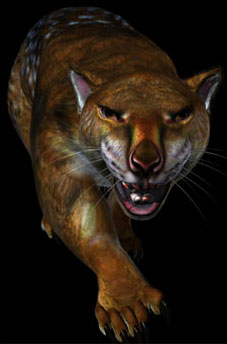Giant carnivorous marsupial beasts not killed by climate change in Australia
Giant carnivorous marsupial beasts not killed by climate change
Evidence points towards human origin of Australian megafauna extinction
mongabay.com
January 25, 2007
Humans, not climate change, caused the extinction of megafauna in Australia contends a team of Australian researchers writing in the January issue of the journal Science.
Australia lost 90 percent of its largest animals, including a saber-toothed kangaroo, a marsupial lion and giant goannas, within 20,000 years of man’s arrival some 50,000 years ago. Scientists have long debated whether the demise of Australian megafauna was due to human arrival, climate change, or a combination of the two factors. The new research found that the climate in southeastern Australia was little different 500,000 years ago, suggesting that climate change was not the ultimate cause of extinction.
“Surprisingly, the climate 500,000 years ago was very similar to that of today, although the region must have had substantially more tree cover to support such a high diversity of herbivores,” said Dr. Gavin Prideaux, a paleontologist at Western Australian Museum and lead author of the paper. “Some time during the last 400,000 years, the Nullarbor vegetation changed from the fire-sensitive woodland to the shrub-grass mosaic we see today. We think that an increase in wildfires best explains the shift, given that climate change was not a significant factor.”
 Computer generated graphic showing what Thylacoleo may have looked like. Image courtesy of the Western Australian Museum. |
Exploring giant limestone caves on Australia’s Nullarbor Plain, Prideaux and colleagues found fossils indicating that the Nullarbor was once home to at least 69 species of mammals, birds and reptiles, including 23 different types of kangaroo — eight of which are new to science. The palaeontologists also uncovered the first complete skeleton of the extinct marsupial lion, Thylacoleo carnifex.
The new results establish that Nullarbor Pleistocene megafauna thrived in dry conditions for at least 400,000 years and that demise appears to correspond to the arrival of humans within the past 50,000 years or so.
“Our work removes another pillar of support from the idea that the megafauna were driven to extinction by climate change, especially given that most of the large species were not Nullarbor specialists — they were widespread across much of Australia,” Dr Prideaux said. “Whether or not increased landscape burning on the Nullarbor is correlated with the arrival of humans, as previous researchers have shown for other parts of Australia, remains to be determined.”
Citation: Gavin J. Prideaux et al. “An arid-adapted middle Pleistocene vertebrate fauna from south-central Australia.” NATURE JAN 25 2007.














